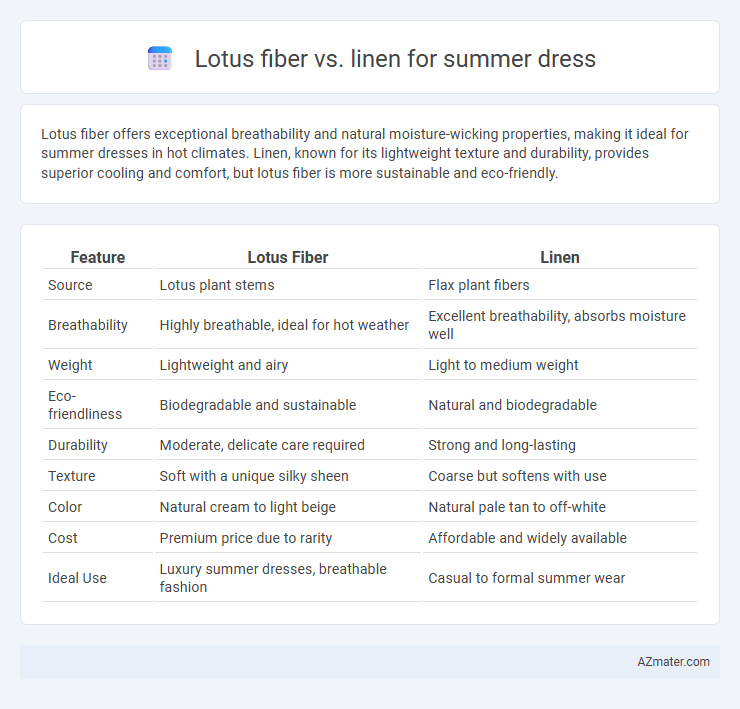Lotus fiber offers exceptional breathability and natural moisture-wicking properties, making it ideal for summer dresses in hot climates. Linen, known for its lightweight texture and durability, provides superior cooling and comfort, but lotus fiber is more sustainable and eco-friendly.
Table of Comparison
| Feature | Lotus Fiber | Linen |
|---|---|---|
| Source | Lotus plant stems | Flax plant fibers |
| Breathability | Highly breathable, ideal for hot weather | Excellent breathability, absorbs moisture well |
| Weight | Lightweight and airy | Light to medium weight |
| Eco-friendliness | Biodegradable and sustainable | Natural and biodegradable |
| Durability | Moderate, delicate care required | Strong and long-lasting |
| Texture | Soft with a unique silky sheen | Coarse but softens with use |
| Color | Natural cream to light beige | Natural pale tan to off-white |
| Cost | Premium price due to rarity | Affordable and widely available |
| Ideal Use | Luxury summer dresses, breathable fashion | Casual to formal summer wear |
Introduction to Lotus Fiber and Linen
Lotus fiber, derived from the stems of lotus plants, offers a lightweight, breathable, and eco-friendly alternative ideal for summer dresses, with natural moisture-wicking and antibacterial properties enhancing comfort. Linen, made from flax fibers, is renowned for its exceptional breathability, durability, and lightweight texture, making it a popular choice for hot weather clothing. Both fibers excel in heat regulation and moisture absorption, yet lotus fiber is distinguished by its rarity and sustainability compared to the widely available, traditional linen.
Origin and Production Process
Lotus fiber, derived from the stems of lotus plants primarily found in Myanmar and Thailand, involves a labor-intensive extraction process where individual fibers are hand-peeled and then sun-dried to create a soft, breathable fabric ideal for summer wear. Linen, sourced from the flax plant cultivated across Europe and parts of Asia, undergoes mechanical retting and scutching to separate fibers before being spun into yarn, resulting in a durable, moisture-absorbing textile favored for its cooling properties. Both fabrics boast eco-friendly origins with unique production techniques that highlight sustainability and natural comfort for lightweight summer dresses.
Environmental Impact Comparison
Lotus fiber production uses fewer pesticides and less water compared to conventional linen, which is typically made from flax requiring significant irrigation and chemical use. Lotus fiber is biodegradable and harvested sustainably from lotus stems without damaging the plant, promoting ecological balance. Linen manufacturing involves more intensive processing that can generate higher carbon emissions and wastewater, making lotus fiber a greener choice for eco-conscious summer dress designs.
Breathability and Comfort in Hot Weather
Lotus fiber offers exceptional breathability and moisture-wicking properties, making it an ideal choice for summer dresses that need to stay cool and dry. Linen, renowned for its natural fibers and airy weave, excels in ventilation and comfort during hot weather, allowing skin to breathe easily. Both fabrics provide superior comfort, but lotus fiber's smooth texture and antimicrobial qualities give it a slight edge for sensitive skin in high temperatures.
Moisture Wicking Abilities
Lotus fiber offers superior moisture-wicking properties compared to linen, making it highly effective at keeping the skin dry and cool in hot weather. Its natural hollow structure enhances breathability and allows rapid evaporation of sweat during summer activities. Linen, while breathable and lightweight, tends to retain moisture longer, which can lead to discomfort in high humidity conditions.
Durability and Longevity
Lotus fiber and linen both offer exceptional durability for summer dresses, with lotus fiber exhibiting remarkable tensile strength and resistance to wear, contributing to enhanced longevity. Linen, derived from flax plants, is well-known for its robust fiber structure and ability to withstand repeated washings without compromising fabric integrity. Choosing lotus fiber or linen ensures a long-lasting summer dress that maintains its texture and appearance over time.
Texture and Visual Appeal
Lotus fiber offers a unique, slightly coarse texture with a natural sheen, making summer dresses visually distinctive and breathable. Linen features a crisp, lightweight texture with a matte finish that enhances its classic, effortlessly elegant look. Both fibers provide excellent airflow, but lotus fiber's subtle golden hue adds a luxurious visual appeal compared to linen's typically muted tones.
Ease of Care and Maintenance
Lotus fiber offers natural antibacterial properties and resistance to wrinkles, reducing the need for frequent washing and ironing compared to linen. Linen, while breathable and lightweight, wrinkles easily and may require gentle hand washing or dry cleaning to maintain its texture and appearance. Both fibers benefit from air drying, but lotus fiber garments typically demand less stringent care, making them more convenient for summer dress maintenance.
Price and Accessibility
Lotus fiber is a rare and expensive material compared to linen, making it less accessible for most consumers seeking affordable summer dresses. Linen, widely available and produced on a large scale, offers budget-friendly options without compromising breathability and comfort. The higher cost of lotus fiber stems from its labor-intensive extraction process, limiting its presence in mainstream fashion markets.
Conclusion: Best Choice for Summer Dresses
Lotus fiber offers superior breathability and moisture-wicking properties, making it an excellent choice for lightweight and comfortable summer dresses. Linen is also highly breathable and provides a durable, natural texture that enhances airflow and coolness in hot weather. For optimal summer dress wear, lotus fiber stands out for its softness and eco-friendly qualities, while linen remains a classic option prized for strength and timeless style.

Infographic: Lotus fiber vs Linen for Summer Dress
 azmater.com
azmater.com